Soldaten der Flakgeschütze!!
When planes dominate the skies, ground operations are riskier and more costly. To allow air cover over the theater of operations, many nations developed various weapons and doctrines during World War II. And the Germans, who based their feared Blitzkrieg on the punctual action of air support, knew very well how effective bombers and fighter-bombers were... And how they "invented" the disease, nothing more logical that they worried about the cure. And light, self-propelled anti-aircraft artillery has always been extensively used by the Germans. Today we are going to see a low-cost but highly effective vehicle, developed within this doctrine. Today we are going to meet the Schwere Geländegängiger Lastkraftwagen 4.5t Mercedes-Benz L4500A als Flakwagen für 3.7cm FlaK 36/37 (Heavy all-terrain truck 4.5t Mercedes-Benz L4500A as anti-aircraft vehicle for 3.7cm FlaK 36/37.)
 |
| Schwere Geländegängiger Lastkraftwagen 4.5t Mercedes-Benz L4500A als Flakwagen für 3.7cm FlaK 36/37. |
History:
The vertiginous development of aviation and the observation of the effectiveness of the plane as a weapon during WWI, propelled a technological race in the period between World War I and World War II, as it became increasingly evident that the corresponding development of material was necessary. and AA tactics to combat and neutralize this new and effective threat.
 |
| The dawn of a new threat: the bomber plane Handley Page 0-400 bomber, built in US by Standard Aircraft- 6 july 1918 |
Although after WWI the Germans were very limited militarily, by virtue of Treaties, they carried out extensive research and testing to develop new AA equipment. In parallel to this, the mechanization of the Armies, with the replacement of animal traction by trucks, added one more factor to this immense puzzle that was the reconstruction of the armed forces in face of the modern armaments of the time. Under the circumstances, it was only logical that some experimentation should take place with the aim of designing a weapon that could be used against aircraft or mechanized ground vehicles and that would be carried, not dragged, to the front. And, with that in mind, engineers began to imagine installing rapid-fire anti-aircraft guns on trucks. This was the birth of self-propelled anti-aircraft artillery.
 |
| British QF 3 inch 20 cwt anti-aircraft gun mounted on a Peerless lorry 1917 -WWI |
 |
German AA truck 7.7 cm Leichte Kraftwagengeschütze M1914 Flanders. August 1917 - WWI |
Trucks were initially used as carriers for anti-aircraft guns of various calibres, as tracked vehicles were not mechanically very reliable yet.
With the end of World War I, many of these efforts were scaled back, but engineers continued to improve and augment the principles of this new concept of anti-aircraft artillery. Tests on vehicles with tracks (now more reliable) began, but trucks offered safer and cheaper options.
In 1936, the Spanish Civil War gave the Germans a chance to test their first efforts in this direction; In 1939, already in WWII, the campaign in Poland allowed a fully operational test of these new products and the results were used as a guide for standardization and further development. And within that context, the Germans chose some heavy trucks to be used as automatic anti-aircraft gun carriers, the 4.5-ton Mercedes Benz being one of them.
History of Mercedes-Benz:
The saga of the Daimler-Benz, owner of the Mercedes-Benz brand, is intertwined with the history of the automobile, from its beginnings. It all started with Gottlieb Daimler and Wilhelm Maybach in Cannstatt, Germany, 1882, developing various types of engines and experimental vehicles.
 |
| Gottlieb Daimler (1834-1900) Wilhelm Maybach (1846-1929) |
These initial works presented the first practical results in 1884, with the advent of the "Grandfather Clock".
 |
| Grandfather Clock engine |
This engine was characterized by generating one HP at dizzying 600 rpm, when the normal engines of that time were mere 120-180 rpm's. These engines were installed in various vehicles, such as a motorcycle Reitwagen in 1885 and culminating in the Daimler automobile in 1886, the world's first car.
 |
| Daimler Petroleum Reitwagen - It is widely recognized as the first motorcycle - 1885. |
 |
| Gottlieb Daimler and his son Adolf on the motor car (motor carriage), 1886. |
The Daimler car was a quadricycle with the basic features of a car, while the vehicle of Karl Benz, another car pioneer who would later become part of the history of this great brand, was a tricycle.
 |
| Karl Benz tricycle - 1886 |
 |
| Karl Benz - 1844- 1929 |
After 10 years of the releasing of its automobile, the first Daimler truck was manufactured in 1886, with Phoenix two cylinders engine, 1100 cc and 04 HPs of power, with a weight of 1200 kg and capacity of load of 1500 kg. Daimler-Motoren-Gesellschaft, from Cannstatt (DMG) made the world's first truck.
 |
| Daimler world's first truck - 1896. |
Meanwhile in 1897, Emil Jellineck, a very prosperous insurance trader who was passionate in speed, goes to Cannstatt to order a two-cylinder Daimler. This transaction would be the beginning of a Jellineck representation across Europe of the special Daimler vehicles with four-cylinder and high-performance engines, which would be called the Daimler-Mercedes. The name Mercedes is due to its daughter, Mercedes Jellineck.
 |
| Emil Jellineck and his daughter, Mercedes. |
The pioneering spirit of these men made them collect other achievements, such as the construction of the first bus, the first gasoline-powered truck, and the world's first diesel truck. Daimler and Benz's work in Germany resulted in the formation in 1926 of Daimler-Benz AG.
The Mercedes Benz L4500 heavy truck:
The Mercedes-Benz L 4500 was built by Daimler-Benz from 1939 - 1944 in the Mercedes-Benz plant Gaggenau, and from 1944 - 1945 by Saurer. The vehicle is a long-bonnet truck and was offered for the military in many versions: the rear-wheel-drive truck 4x2 L4500S, the all-wheel-drive truck 4x4 L4500A and the half-track truck L4500R.
All these versions could come with two types of cabin: the normal rounded civil cabin and the Einheitsfahrerhaus (standard cabins) simplified standardised cabin, with rectangular lines and flat mudwings. These simplified cabins appeared from 1943 onwards and can be seen on all versions of the Mercedes-Benz L4500, after that date.
- 4x2 rear-wheel-drive truck (L4500S).
- 4x4 all-wheel-drive truck (L4500A)
 |
| Mercedes-Benz L4500A (civil cabin) Notice the drive front axle (4x4) |
- Half-track Maultier (L4500R).
Description:
The L 4500 was a long hood truck, with a U-shaped ladder-type chassis with two beam axles. Both axles had semi-elliptical spring suspensions. The front axle had single wheels while the rear axle had twin wheels. The tyres had the size 10.5-20". An air-hydraulic brake-system was used, each wheel with a drum brake and the parking brake locking the rear wheels only. For steering, a ZF Type 721 steering system was used.
From the engine, the torque was transmitted to a five-speed manual gearbox with a single disc dry clutch. The gearbox had a reduction gear. In the L4500S version, only the rear wheels were driven. In the 4x4 L4500A version, the truck has an offroad gear, which automatically switches on the front-wheel drive and disables even torque distribution.
The Mercedes-Benz OM 67/4 Diesel engine was installed in the L4500. It is a six-cylinder, straight, four-stroke, precombustion-chamber-injected, water-cooled diesel engine with OHV-Valvetrain.
 |
| Mercedes-Benz OM 67/4 Diesel engine |
The AA armoured ruck:
After many field experiences, with automatic anti-aircraft guns precariously installed on truck loading platforms, it was found that this concept could be improved.
 |
| Mercedes Benz L4500A with civil cabin and standard loading platform as improvised self-propelled AA gun, with Quad FlaK 38 2,0 cm AA gun. Somewhere in African Desert - 1942 |
The anti-aircraft gun was mounted on a 360° rotating base in the middle of the original cargo area, behind the cabin. The original sidewalls were replaced with new ones lined with resistent wire mesh. During preparation for firing, these side walls were folded at 90°, freeing up space for the weapon's rotation and increasing the crew's circulation area.
An effective anti-aircraft weapon needs stability in order to keep up with the fast trajectory of the target. To increase the stability of the gun during the sequence of shots, two supports were installed on each side, at the ends of the loading area. These supports were telescopic and folded downwards, resting on the ground and providing a stable platform for the gun firing. These same supports were folded upwards during vehicle displacement.
Even after installing the nearly two tons of armament, there was still enough payload to armor the cabin. Riveted armor plates, in a quadrangular shape, formed the "box" of the cabin. There were two front portholes protected by armored glass, as well as two side portholes and a rear porthole for the driver. In addition, the frontal portion of the engine and radiator received armor in the form of a steel plate bent in a V, which rested on the front bumper and was stabilized by tie rods in the upper portion of the hood.
The crew consisted of four to five men, depending on which weapon they carried. In addition to the commander and driver, there were also a loader (or two) and a gunner. But it was not uncommon for larger crews, as a greater amount of loaders increased the weapon's rate of fire.
The gunner and loader(s) were protected by the gun's own frontal shields. Only a minimal supply of ammunition was loaded aboard the vehicle, for initial use. The rest of the ammunition was usually transported by trailer dragged by the antiaircraft truck itself or by a standard cargo truck.
The L4500A with armoured cabin trucks could carry several automatic weapons, namely: The 3,7cm FlaK 36, the 5,0cm FlaK 41 and 2,0cm Flakvierling 38. There were slight differences between trucks when carrying different weapons. The first version produced was the 3.7 cm, followed by the 5.0 cm and finally, the 2.0 cm quadruple.
 |
| Mercedes-Benz L4500A (armoured cabin) with 3,7cm Flak 36/37 - crew: 4 |
 |
| Mercedes-Benz L4500A (armoured cabin) with 5,0cm Flak 41 - crew: 4 |
 |
| Mercedes-Benz L4500A (armoured cabin) with 2,0cm Flakvierling 38 crew: 5 (two loaders) |
 |
| Line of 3.7cm FlaK 36/37 Schwere Geländegängiger Lastkraftwagen 4.5 t's rolling in the south of France (near Toulon) during Operation Asche |
 |
| Anpther view of 3.7cm FlaK 36/37 Schwere Geländegängiger Lastkraftwagen 4.5 t's rolling in the south of France (near Toulon) during Operation Asche |
 |
| The crew of a Mercedes Benz L4500A 3.7cm FlaK 36/37 happily poses for the camera. Here we see seven soldiers, with the weapon in a stabilized firing position. |
 |
| A Schwere Geländegängiger Lastkraftwagen 4.5t Mercedes-Benz L4500A als Flakwagen für 5.0cm FlaK 41 in firing position. |
 |
| A Mercedes Benz L4500A 5,0cm FlaK 41 with the crew on standby. This truck features an open armored cab with no radiator guard. Notice the camouflage net. |
 |
| The same vehicle above, in side view. |
 |
| A Schwere Geländegängiger Lastkraftwagen 4.5t Mercedes-Benz L4500A als Flakwagen für 2,0cm Flakvierling 38 with standard 5 men crew. |
 |
A Schwere Geländegängiger Lastkraftwagen 4.5t Mercedes-Benz L4500A als Flakwagen für 2,0cm Flakvierling 38 towing the standard Sonderanhänger (1 achs.) (Sd. Ah. 52) ammo trailer. Notice the camo in 3 tones and absence of side walls of the engine hood. Somewere in France - 1944. |
The exact number of pieces produced is unknown, but probably not many. In all three cases, these weapon systems can be thought of as a gap-filling solution, something more or less temporary. The combat value of these machines was greatly limited by the low level of crew protection (the gunner and loaders were carried exposed) and the operational limitations of using a wheeled vehicle (poor off-road performance and tires that could be easily destroyed). But they did their job very well, while better and better protected weapons (Flakpanzers) were not yet available in sufficient quantities.
 |
| Flakpanzer IV Möbelwagen 3,7cm Flak 43 |
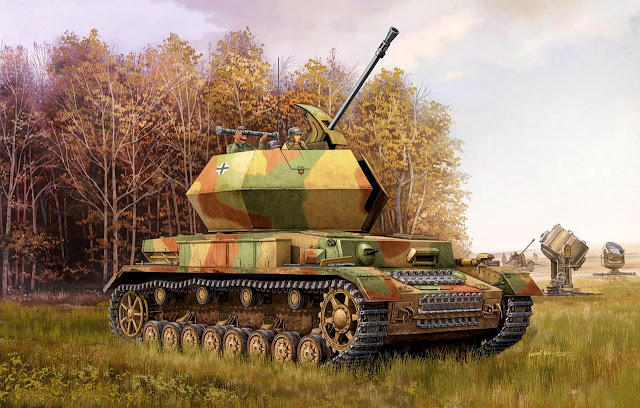 |
| Flakpanzer IV Ostwind with 3.7cm Flak 43 |
Specs:
| Mercedes-Benz L4500 AA armoured truck | |
|---|---|
| Type | Truck |
| Manufacturer | Daimler-Benz AG |
| Production | 1939 – 1945 |
| Assembly | Germany: Gaggenau Austria: Simmering |
| Body and chassis | |
| Class | AA armoured 4,5 t truck |
| Body style | long bonnet truck |
| Layout | Front engine, 4x4 (A) |
| Platform | L 4500 |
| Powertrain | |
| Engine | Mercedes-Benz OM 67/4, Diesel - 7274 cm3, 120 hp |
| Transmission | Manual five-speed |
| Propulsion | Tyres |
| Dimensions | |
| Wheelbase | 4600 mm |
| Length | 7860 mm |
| Width | 2350 mm |
| Height | 3345 mm |
| Total weight Fording height Max speed Consumption | 10.420 kg 80 cm 66 Km/h (road) 3,7 Km/l |
The kits:
The models that will be used in this project are Mercedes-Benz truck L4500A mit 3.7cm Flak 37 by Trumpeter (#09593) and the Einheitsanhanger 5 t trailer by Das Werk (#DW35006).
 |
| Kojak with the two kits on the workbench... The bald man hadn't spoken German in a while... |
The concept of the idea is that this armoured truck (which Trumpeter insists on not mentioning the name... It's a MERCEDES-BENZ !!!) is moving from one operating position to another. And since it's on the road, it would be dragging a 5-ton trailer with material to the new base of operations.
After all, a truck is and always will be a truck... And before any purists say this would be wrong (where has a FlaK-truck ever pulled anything other than its proper ammo trailer???), here's photographic proof that a FlaK-truck is, first and foremost, a truck... and trucks serve to load and pull things....
 |
| A destroyed Mercedes L4500A with a 3.7cm FlaK gun pulling an 88mm FlaKgun. Shot taken by Lt.Stuart Hills of C Squadron at Het Zonneke, South of Geel Belgium- 10 September 1944. |
But enough rambling... Let's build these beauties... Starting with the truck..., following the booklet, let's face the engine:
 |
| The engine is very well detailed... Too bad he has to be enclosed inside the nose of the truck... |
 |
| Unless.... hmmmm.... here we go... |
The chassis features well-injected parts, without deformations or burrs. Keeping everything lined up is a no-brainer (but that doesn't mean alignment falls out of the sky into your lap...)
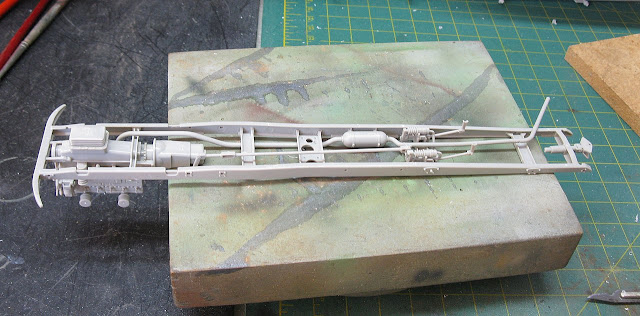 |
| Belly view of the chassis under construction... A cool part to build, in the kit... |
 |
| Chassis under construction... Notice the engine, accessories and suspensions in place... left view |
 |
| Chassis under construction... Notice the engine, accessories and suspensions in place... right view |
Trumpeter didn't skimp on the pin-marks... Some would be extremely visible as I'm going to build the cockpit with the captain's hatch open. The internal pin-marks of the ceiling I will close for conscience sake...
 |
| Pin-marks...Man, they are many and evident, in the cabin... Putty time!! |
 |
| To level the putty, nothing like using my sander Panzerserra made with an electric toothbrush |
 |
| Testing the fit of parts. Positive point for the Trumpeter: everything fits very well!!! |
As I said above, it's a shame to have to close the engine inside the front hood. And, seeing this photo, the will that arises is: Let's open our girl's engine compartment???
 |
| How about we refresh our girl's heart a little??? |
As Trumpeter doesn't make things easy in that sense, we're going to a surgery that, although simple, must be performed with care... The first thing is to deepen the tiny groove between the sides of the engine hood. I used the scalpel with the help of a metal ruler... It's like "little-plane-builders" do to scribing the fuselage panels lines.
 |
| Using the scalpel to deepen the lines and allow the plastic to be cut. |
 |
| Compare the parts with the surgery done (left - red arrow) and not yet performed (right). I made the groove on both sides of the piece (external and internal) |
 |
| Using the PE bending tool to "fracture" the pieces cleanly and straight. |
 |
| Surgery done. The part marked with the red "X" will go to the scrap box |
 |
| Repeating the process on the other side. Notice the practically built armored cabin in the background. |
 |
| Testing the fit of the engine hood, with the sides open. |
 |
| Building the engine hood, with the sides open. I really liked the result... |
 |
| Testing the fit of the cabin floor. Everything fits together wonderfully. Well done, Trumpeter!!! |
 |
| Left view... The cabin floor fits perfectly.... |
 |
| Squaring is essential. Mudguards and floor fit perfectly... One reinforcing the other... |
 |
| Installing the cabin floor. Everything fits perfectly.... Our architect is happy!!! |
 |
| The cabin glued!!! |
 |
| Primer application, for the internal painting of the cabin and chassis |
 |
| These vehicles were usually painted in Panzer-gray. Let's make your interior and bottom with this color... |
 |
| Chassis in Panzer-gray right view |
 |
| Chassis in Panzer-gray left view |
 |
| The armoured cabin in PG |
 |
| Weathering in the chassis painting... right view |
 |
| Weathering in the chassis painting... left view |
 |
| Weathering in the cabin interior... |
 |
| Weathering in the seat, dashboard instruments and armoured doors... |
 |
| The instrument panel installed inside the cabin. View through Commander's hatch. |
 |
| Cabin interior details. Right view |
 |
| Cabin interior details. Left view |
 |
| Closing the doors... left view |
 |
| Closing the doors... right view |
 |
| Details in the engine hood... |
 |
| The wheels and vinyl tires.... The tires are easily removable from the wheels (they are very soft). This will make painting easier... |
 |
| Gluing the wheels in a well-aligned and squared way. The presence of tires at this stage makes the work perfect |
 |
| As always, squaring is key... |
 |
| Our girl looking simply wonderful. Now yes, she looks like a badass truck ... left view |
 |
| Right view |
 |
| Starting construction of truck loading area... PE panels fit perfectly.... Left view |
 |
| Truck loading area... Left view |
Here, a blunder by Trumpeter: it left the toolboxes bottomless (blue arrows). The first impression is that they would be covered by the sub-chassis, but this is not the case. The way is to apply a thin strip of plasticard (0.3mm - green arrow) so that the Krauts can celebrate that they won't lose their tools along the way!
 |
| Karl, Fritz and Hans can celebrate Kojak's care in building the truck... Notice the spare wheel rack in position... |
 |
| The toolboxes closed (as it should be). Karl is very happy!!! |
 |
| Notice the gap between the sub-chassis and the bottom of the box... What an ugly thing, Trumpeter!!! Good thing Kojak is a capricious fellow... |
 |
| While the loading area dries the glue, let's build the stabilizing legs... |
 |
| Stabilizing legs in position and movable... right view |
 |
| Stabilizing legs in position and movable... left view |
 |
| Adding details and fenders to the bottom of the cargo area left view |
 |
| Adding details and fenders to the bottom of the cargo area Right view |
 |
| And gluing the cargo area to the chassis and cab. The truck is completely rigid, with the cargo area-cab-chassis connection. This rigidity should increase the weapon's shooting stability... right view |
 |
| Left view |
 |
| Belly view |
Prevention is better than cure... The width beacons are the most broken parts in a model. I'm going to replace the (fragile) plastic parts with two metal pins. Although the spheres are smaller, it's a small price to pay when it comes to toughness...
 |
| Replacing the (thin and fragile - red arrows) plastic parts by two metal pins (blue) |
 |
| Much better... Notice other details added Left view |
 |
| Well...the girl's construction is practically done. Let's now take care of the AA gun... |
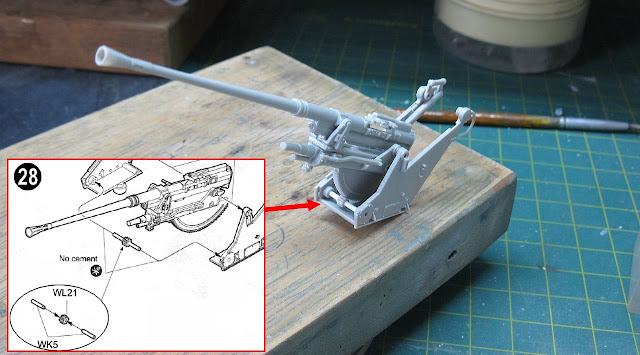 |
| Replacing the absurd engineering solution of two pins retaining the gun's lifting pinion with a single axis, in plasticard. |
 |
| The 37mm gun, under construction... |
 |
| Adding details... |
 |
| Indeed, it is a very respectable weapon... |
 |
| Testing the 37mm FlaK 41 in its place. Dude, this thing looks amazing!!! |
 |
| Front view |
 |
| Right view |
 |
| Rear view |
 |
| Gun details... |
And, after everything is finished, we move on to the primer application step, as we try to locate this girl in time and space. My client requested a post-February 1942 paint job in the dark yellow brindle with green and brown pattern. The decals from the kit are for vehicles in the panzer-gray pattern, so let's do some research...
 |
| The primer under drying...note that another kit is under construction. It will be described in parallel. |
Guys, I hate the famous phrase: "Unidentified unit" in the Painting & marking guides! If these manufacturers got in touch with a modeling club, I guarantee they would solve this issue in minutes... and at a very low cost...Too lazy to research, Miss Trumpeter!!! Shame on you!!
 |
| Trumpeter, you guide sucks!!! |
As my old and wise father used to say: "If you want something done right, do it yourself!" So let's make a decent, historically accurate painting and markings guide: a Panzerserra one!! Let's meet the Mercedes Benz L4500A Schwere Geländegängiger Lastkraftwagen als Flakwagen für 3.7cm FlaK 36/37 number 4, belongs to SS FlaK Abteilung 12, in the 12. SS-Panzer-Division Hitlerjugend, in the critical times of the Overlord Operation, Normandy, France, in June 1944.
 |
| A good reference for our Mercedes... Panzerserra's guide of markings & painting. |
Let's start painting with the dark yellow base color...
 |
| The truck and the gun, under yellow colors.... |
 |
| The 3,7cm FlaK is a very beautiful detail... |
I insulated the undersides of the truck, which were already painted panzer-gray. Usually, the camouflages striped in green and brown on yellow were executed on the battlefields, with only the outermost parts being painted...
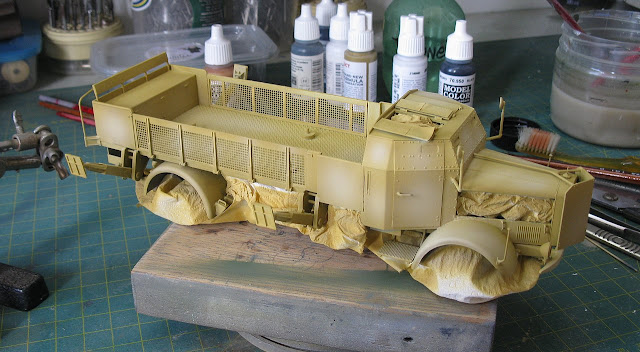 |
| Dark-yellow in the truck... |
 |
| And after using the green and brown colors with an airbrush... The girl is getting more showy and more colorful!!! right side |
 |
| left side view |
 |
| 3/4 front left view |
 |
| 3/4 rear right view |
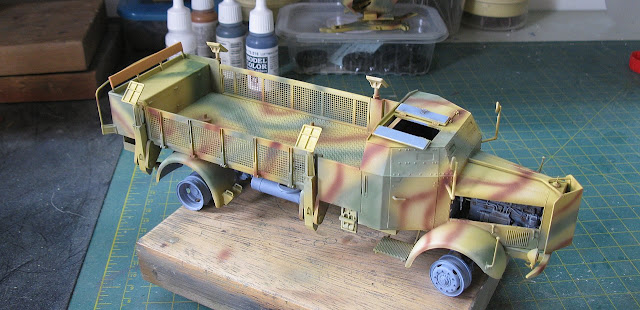 |
| Sooo cooolll!! |
After a thin application of Pledge (Future) to avoid silvering, let's apply the decals...
 |
| Mercedes Benz L4500A Schwere Geländegängiger Lastkraftwagen als Flakwagen für 3.7cm FlaK 36/37 number 4 SS FlaK Abteilung 12 - 12. SS-Panzer-Division Hitlerjugend Overlord Operation, Normandy, France - June 1944 |
 |
| Mercedes Benz L4500A Flakwagen für 3.7cm FlaK 36/37 front left view |
 |
| Mercedes Benz L4500A Flakwagen für 3.7cm FlaK 36/37 front right view |
 |
| Mercedes Benz L4500A Flakwagen für 3.7cm FlaK 36/37 rear view |
 |
| Mercedes Benz L4500A Flakwagen für 3.7cm FlaK 36/37 front view |
Adding some more details to the truck. As my client wanted the vehicle in running position, I decided to add some more cargo to the Mercedes, because in addition to our girl being a weapon, she is still a truck... And as she was on the move, nothing more correct than carrying a little supplies in the cargo area...
 |
| Notice the crates and fuel drums in the cargo area... plus a little more ammo, of course... |
 |
| This German girl is really pretty!!! |
 |
| I'm still going to tie these fuel drums to the cargo structure... |
 |
| Mercedes Benz L4500A Flakwagen für 3.7cm FlaK 36/37 left view |
 |
| Mercedes Benz L4500A Flakwagen für 3.7cm FlaK 36/37 rear left view |
 |
| Mercedes Benz L4500A Flakwagen für 3.7cm FlaK 36/37 rear right view |
And after a few more details, our girl who hates planes was ready. With you, the Mercedes Benz L4500A Schwere Geländegängiger Lastkraftwagen als Flakwagen für 3.7cm FlaK 36/37 number 4, providing services with SS FlaK Abteilung 12, in the 12. SS-Panzer-Division Hitlerjugend, in the incredible days of the Overlord Operation, Normandy, France, in June 1944.
 |
| Mercedes Benz L4500A Schwere Geländegängiger Lastkraftwagen als Flakwagen für 3.7cm FlaK 36/37 - number 4 SS FlaK Abteilung 12 - 12. SS-Panzer-Division Hitlerjugend, Normandy, France - June, 1944. |
 |
| Mercedes Benz L4500A Schwere Geländegängiger Lastkraftwagen als Flakwagen für 3.7cm FlaK 36/37 front left top view |
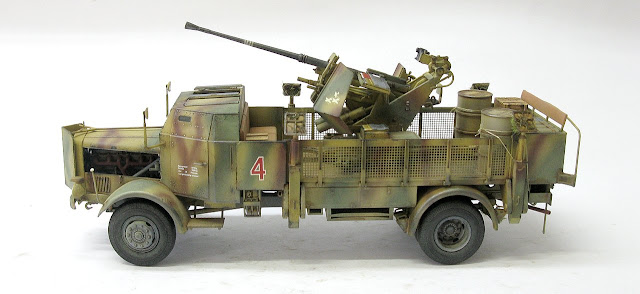 |
| Mercedes Benz L4500A Schwere Geländegängiger Lastkraftwagen als Flakwagen für 3.7cm FlaK 36/37 left view |
 |
| Mercedes Benz L4500A Schwere Geländegängiger Lastkraftwagen als Flakwagen für 3.7cm FlaK 36/37 top view |
 |
| Mercedes Benz L4500A Schwere Geländegängiger Lastkraftwagen als Flakwagen für 3.7cm FlaK 36/37 rear left view |
 |
| Mercedes Benz L4500A Schwere Geländegängiger Lastkraftwagen als Flakwagen für 3.7cm FlaK 36/37 rear right top view |
 |
| Mercedes Benz L4500A Schwere Geländegängiger Lastkraftwagen als Flakwagen für 3.7cm FlaK 36/37 rear right view |
 |
| Mercedes Benz L4500A Schwere Geländegängiger Lastkraftwagen als Flakwagen für 3.7cm FlaK 36/37 right view |
 |
| Mercedes Benz L4500A Schwere Geländegängiger Lastkraftwagen als Flakwagen für 3.7cm FlaK 36/37 front right view |
 |
| Mercedes Benz L4500A Schwere Geländegängiger Lastkraftwagen als Flakwagen für 3.7cm FlaK 36/37 front left view. Notice the stabilizer legs in fire position... |
 |
| Kojak and Rover, the dog, catching a ride on the Mercedes... |
 |
| The bald one is very happy!!! |
 |
| Mercedes Benz L4500A Schwere Geländegängiger Lastkraftwagen als Flakwagen für 3.7cm FlaK 36/37 and Einheitsanhänger 5t Baumuster E5 |
 |
| Mercedes Benz L4500A Schwere Geländegängiger Lastkraftwagen als Flakwagen für 3.7cm FlaK 36/37 towing the Einheitsanhänger 5t Baumuster E5 |
 |
| Mercedes Benz L4500A Schwere Geländegängiger Lastkraftwagen als Flakwagen für 3.7cm FlaK 36/37 towing the Einheitsanhänger 5t Baumuster E5 with Kojak and Rover, the dog. |
 |
| Mercedes Benz L4500A Schwere Geländegängiger Lastkraftwagen als Flakwagen für 3.7cm FlaK 36/37 - number 4 SS FlaK Abteilung 12 - 12. SS-Panzer-Division Hitlerjugend, Normandy, France - June, 1944. |
Bleib bei uns!!!









What a cool project! The only "bad" thing about your blog is when I see you do a project, I want one too. The Mercedes trucks are very interesting. I want to do an L4500S for Afrika Korps.
ResponderExcluirI'm still in-progress on my 1/35 Takom M48A5 kit, the link-by-link tracks are amazingly detailed but time-consuming to build, especially when I'm doing wear on the track pads. I'll send photos when it's done. I just acquired an Eduard P-400 Airacobra in 1/48, plus extra details for it. It's the first piston-engine kit I've bought in over a decade.
Hi Tank Girl!!!
ExcluirIt's good to see you back here... So the Bunker keeps waking up crazy ideas about modeling in you??? But this is the intention... And it looks like I'm reaching my goals!! It's great to have feedback like yours... Thank you very much!!
P-400?!? The export version of the P-39??? I always thought this plane was beautiful... Too bad its Alison engine was kind of anemic... I wonder if they had installed a Packard/Merlin in them... like they did with the Mustangs... I don't think it would be considered as " ...a P-40 with a Zero on the tail" At least that's how the guys referred to the P-400s... But they did a good job in the Pacific Islands, when employed with correct tactics.
Good fun, tank-girl!!!
You have a beautiful piece of history in your hands!!!
And don't forget to send me pictures of your tank when ready.
A big hug and come back often!!!
~hugs~ to you!
ExcluirI do indeed get ideas and inspiration from your blog. I especially admire how you fix some probably frustrating design flaws and also how you make older kits shine!
The P-400 I will do is USAAF 80th Fighter Squadron, with a kill marking from New Guinea. I've liked Airacobras since I first saw a photo of one, a very stylish airplane. My model will have my approximations of the Dupont version of RAF paint, and a big shark's mouth.
A very good choice, no doubt!!! Have fun with your project, Tank-girl!!! Cheers!!!
Excluir